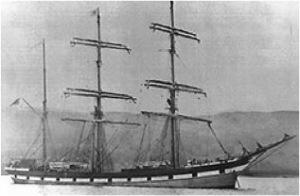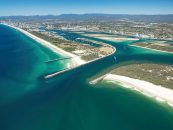A considerable amount of Queensland’s history is told in the scraps of tangled wreckage and mouldering wood and iron that lie scattered along her coastline. Different years of shipping are identical with various developments of the State. And the shipping, in its turn, has left behind these pathetic reminders of past tragedies.
The weather was not always the destroyer. A sailing ship caught in a strong current or a savage tidal rip, especially in light or adverse breezes, was doomed. And sometimes the dreadful grinding crash came in fair weather, when she drove unexpectedly on to an uncharted reef or rock pinnacles.
For a shipmaster whose navigation was partly “by guess or by God” sailing along the east coast of Australia, danger was an integral part of his life. It is ironic that he was often in greatest danger when he had passed through a storm and was within a few miles of his destination on a savage coast.
THE COOLANGATTA
Coolangatta, an 88-tonne vessel was entered into the British Register of Shipping (Sydney, 10/1844) and was wrecked on 19 August 1846. The Coolangatta was trying to enter the Tweed River during a gale when it was driven ashore northward of the River. The captain and several of the crew were ashore at the time attempting to locate a water source. The Coolangatta soon beached and the crewmembers stripped the vessel of all removable gear. The crew then travelled overland to Amity Point where they were recovered by the steamer Tamar and conveyed to Sydney.
In December of 1846, an attempt was made to re-float the vessel. According to Captain Freeman of the vessel William, the vessel had been lifted out of the sand by rollers. But just as arrangements had been completed for the launch (including repairs and the discharging of cargo) a gale forced the vessel into a worse position than before.
In 1883, surveyor Henry Schneider named the creek and the township after the wreck. A fragment of the wreck of the “Coolangatta” is located in Queen Elizabeth Park on the Coolangatta foreshore.
Note: A portion of a wreck was washed ashore on North Kirra Beach in 1974, “more than 120 metres north-west from where the vessel went down”. The identification of this wreck as the “Coolangatta” has been disputed by historian Harry Lauder, who considered that the beach on which the vessel was driven ashore was on Duranbah Beach, and not North Kirra.
—–
THE SCOTTISH PRINCE
On 3 February 1887, under the Command of William Little, the Scottish Prince was proceeding northward along the east coast on the final stages of a voyage from Glasgow to Brisbane. At 11:40pm the master left the deck, leaving the second mate in charge—who had never sailed these waters before. Shortly after midnight the vessel ran aground.
Several unsuccessful attempts were made by the steamers Tweed, Otter and Gunga to tow the Scottish Prince off the bar. Within a few days, as southeasterly weather conditions deteriorated, the vessel keeled over and was abandoned.
Over the following weeks, the decks opened up allowing cases of cargo including sewing machines, drapery, whiskey, beer and mineral waters to be washed ashore.
The wreck was discovered on 1 October 1955. In 1956, over 140 dives were made to identify the vessel as that of the Scottish Prince. She was an iron ship of 894 tons with a length of 210 ft.
—-
THE CAMBUS WALLACE
A barque rigged ship of 800 tons bound from Glasgow to Brisbane was wrecked and driven ashore during a storm on 3 September 1894. Five members of her crew were drowned. A monument was erected by subscription and a broken spar and part of a wheel were erected over their grave on the terrace. A valuable cargo of printers’ paper, oil, ammunition and spirits was lost or ruined by the seawater. There were 4000 cases of whisky and a quantity of ironmongery.
A man named Kirk bought the wreck, which by this time was partly covered by sand. And to uncover his property, he blew up the ship with dynamite. This explosion caused a big hole in the sand about 30ft wide by 12 or 15ft deep, and loosened the sand round about. There followed after a big king tide and heavy gale and the sea broke through. In a week, the passage was 100 ft. wide.
The figurehead of the Cambus Wallace is still standing near the Railway Hotel at Southport. Mr. Barney Boulton has the nameplate from one of the cabin doors.
Information provided by Southport Yacht Club’s Maritime Heritage Ship Wreck committee.
Main photo by Ian Banks






























